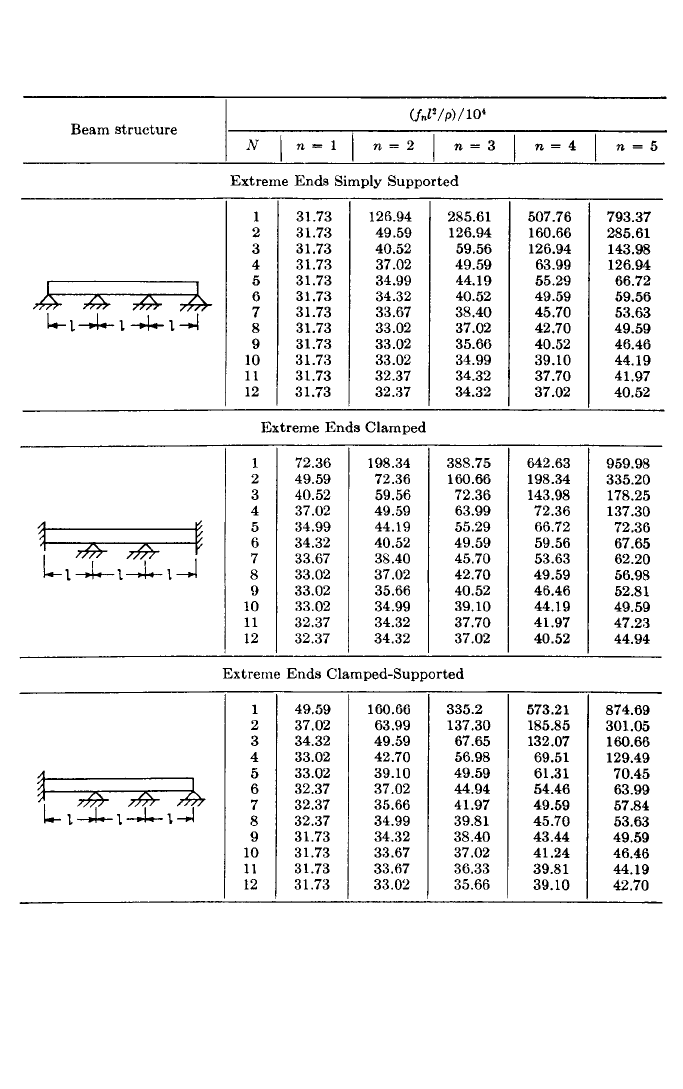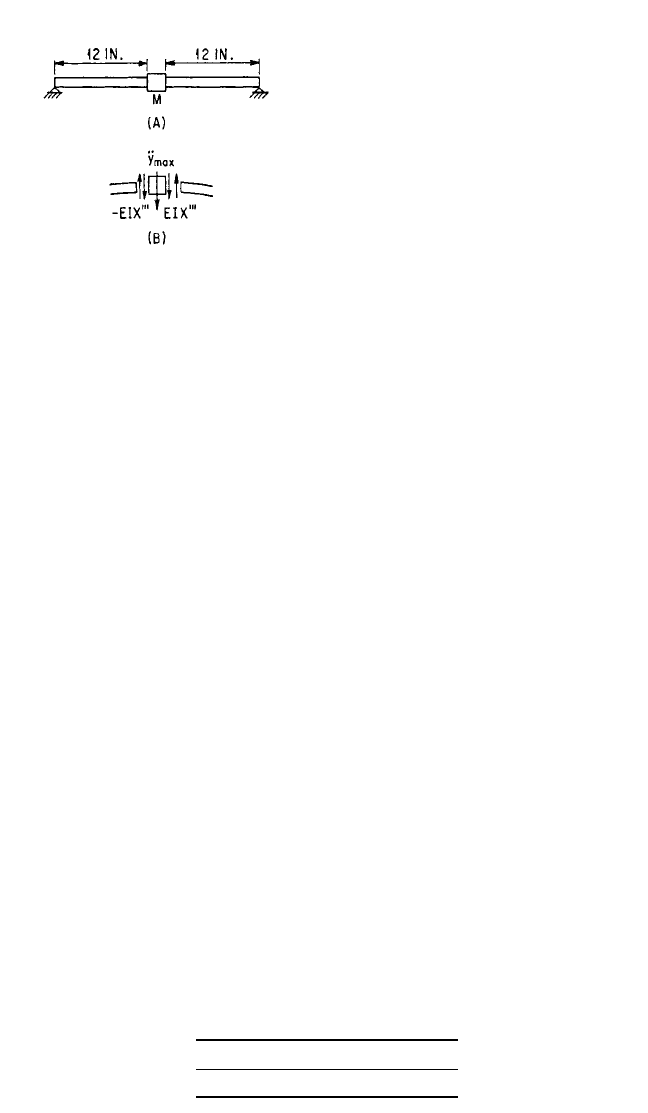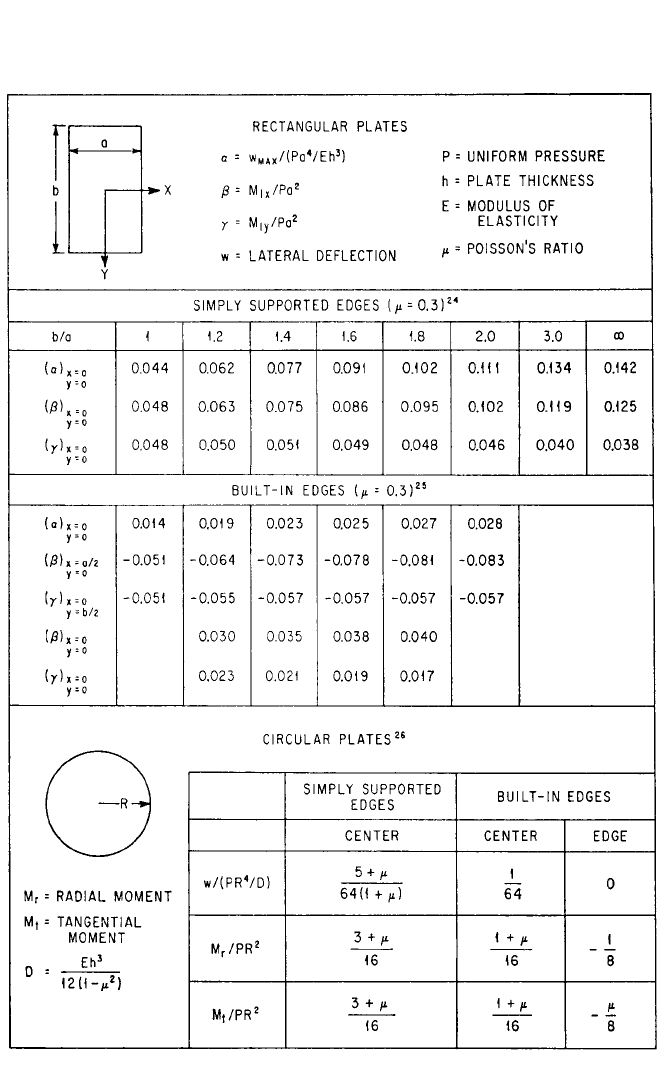Harris C.M., Piersol A.G. Harris Shock and vibration handbook
Подождите немного. Документ загружается.


Rayleigh’s or Ritz’s method can be used to find approximate values for the fre-
quencies of such beams. The frequency equation becomes, using the equations in
Table 7.1, and letting Y(x) be the assumed deflection,
ω
n
2
=
where I = I(x) is the moment of inertia of the cross section and S = S(x) is the area of
the cross section. Examples of the calculations are in the literature.
18
If the values of
I(x) and S(x) cannot be defined analytically, the beam may be divided into two or
more sections, for each of which I and S can be approximated by an equation. The
strain and kinetic energies of each section may be computed separately, using an
appropriate function for the deflection, and the total energies for the beam found by
adding the values for the individual sections.
Continuous Beams on Multiple Supports. In finding the natural frequencies of
a beam on multiple supports, the section between each pair of supports is considered
as a separate beam with its origin at the left support of the section. Equation (7.16)
applies to each section. Since the deflection is zero at the origin of each section,
A = 0 and the equation reduces to
X = B(cos κx − cosh κx) + C(sin κx + sinh κx) + D(sin κx − sinh κx)
There is one such equation for each section, and the necessary end conditions are as
follows:
1. At each end of the beam the usual boundary conditions are applicable, depend-
ing on the type of support.
2. At each intermediate support the deflection is zero. Since the beam is continuous,
the slope and the moment just to the left and to the right of the support are the
same.
General equations can be developed for finding the frequency for any number of
spans.
19,20
Table 7.5 gives constants for finding the natural frequencies of uniform
continuous beams on uniformly spaced supports for several combinations of end
supports.
Beams with Partly Clamped Ends. For a beam in which the slope at each end is
proportional to the moment, the following empirical equation gives the natural fre-
quency:
21
f
n
= f
0
n +
n +
where f
0
is the frequency of the same beam with simply supported ends and n is the
mode number. The parameters β
L
= k
L
l/EI and β
R
= k
R
l/EI are coefficients in which
k
L
and k
R
are stiffnesses of the supports as given by k
L
= M
L
/θ
L
, where M
L
is the
moment and θ
L
the angle at the left end, and k
R
= M
R
/θ
R
, where M
R
is the moment
and θ
R
the angle at the right end.The error is less than 2 percent except for bars hav-
ing one end completely or nearly clamped (β>10) and the other end completely or
nearly hinged (β<0.9).
β
R
5n +β
R
1
2
β
L
5n +β
L
1
2
l
0
I (d
2
Y/dx
2
)
2
dx
l
0
SY
2
dx
Eg
γ
VIBRATION OF SYSTEMS HAVING DISTRIBUTED MASS AND ELASTICITY 7.23
8434_Harris_07_b.qxd 09/20/2001 11:24 AM Page 7.23

7.24 CHAPTER SEVEN
TABLE 7.5 Natural Frequencies of Continuous Uniform Steel* Beams (J. N. Macduff and
R. P. Felgar.
16, 17
)
* For materials other than steel, use equation at bottom of Table 7.4.
f
n
= natural frequency, Hz n = mode number
ρ=I/
S
= radius of gyration, in. N = number of spans
l = span length, in.
8434_Harris_07_b.qxd 09/20/2001 11:24 AM Page 7.24

LATERAL VIBRATION OF BEAMS WITH MASSES ATTACHED
The use of Fig. 7.4 is a convenient method of estimating the natural frequencies of
beams with added loads.
Exact Solution. If the masses attached to the beam are considered to be rigid
so that they exert no elastic forces, and if it is assumed that the attachment is such
that the bending of the beam is not restrained, Eqs. (7.13) and (7.16) apply. The sec-
tion of the beam between each two masses, and between each support and the adja-
cent mass, must be considered individually. The constants in Eq. (7.16) are different
for each section. There are 4N constants, N being the number of sections into which
the beam is divided. Each support supplies two boundary conditions. Additional
conditions are provided by:
1. The deflection at the location of each mass is the same for both sections adjacent
to the mass.
2. The slope at each mass is the same for each section adjacent thereto.
3. The change in the lateral elastic shear force in the beam, at the location of each
mass, is equal to the product of the mass and its acceleration ÿ.
4. The change of moment in the beam, at each mass, is equal to the product of the
moment of inertia of the mass and its angular acceleration (∂
2
/∂t
2
)(∂y/∂x).
Setting up the necessary equations is not difficult, but their solution is a lengthy
process for all but the simplest configurations. Even the solution of the problem of a
beam with hinged ends supporting a mass with negligible moment of inertia located
anywhere except at the center of the beam is fairly long. If the mass is at the center
of the beam, the solution is relatively simple because of symmetry and is illustrated
to show how the result compares with that obtained by Rayleigh’s method.
Rayleigh’s Method. Rayleigh’s method offers a practical method of obtaining a
fairly accurate solution of the problem, even when more than one mass is added. In
carrying out the solution, the kinetic energy of the masses is added to that of the
beam. The strain and kinetic energies of a uniform beam are given in Table 7.1. The
kinetic energy of the ith mass is (m
i
/2)ω
n
2
Y
2
(x
i
), where Y(x
i
) is the value of the ampli-
tude at the location of mass. Equating the maximum strain energy to the total maxi-
mum kinetic energy of the beam and masses, the frequency equation becomes
ω
n
2
=
EI
l
0
(Y″)
2
dx
(7.19)
l
0
Y
2
dx +
n
i = 1
m
i
Y
2
(x
i
)
where Y(x) is the maximum deflection. If Y(x) were known exactly, this equation
would give the correct frequency; however, since Y is not known, a shape must be
assumed. This may be either the mode shape of the unloaded beam or a polynomial
that satisfies the necessary boundary conditions, such as the equation for the static
deflection under a load.
Beam as Spring. A method for obtaining the natural frequency of a beam with
a single mass mounted on it is to consider the beam to act as a spring, the stiffness
of which is found by using simple beam theory. The equation ω
n
= k/m
is used.
Best accuracy is obtained by considering m to be made up of the attached mass plus
some portion of the mass of the beam. The fraction of the beam mass to be used
depends on the type of beam. The equations for simply supported and cantilevered
beams with masses attached are given in Table 7.2.
γS
g
VIBRATION OF SYSTEMS HAVING DISTRIBUTED MASS AND ELASTICITY 7.25
8434_Harris_07_b.qxd 09/20/2001 11:24 AM Page 7.25

EXAMPLE 7.7. The fundamental nat-
ural frequencies of a beam with hinged
ends 24 in. long, 2 in. wide, and
1
⁄4 in. thick
having a mass m attached at the center
(Fig. 7.9) are to be calculated by each of
the three methods, and the results com-
pared for ratios of mass to beam mass of
1, 5, and 25. The result is to be compared
with the frequency from Fig. 7.4.
EXACT SOLUTION. Because of sym-
metry, only the section of the beam to
the left of the mass has to be considered
in carrying out the exact solution. The
boundary conditions for the left end are:
at x = 0, X = 0, and X″=0. The shear
force just to the left of the mass is nega-
tive at maximum deflection (Fig. 7.9B) and is F
s
=−EIX″′; to the right of the mass,
because of symmetry, the shear force has the same magnitude with opposite sign.
The difference between the shear forces on the two sides of the mass must equal the
product of the mass and its acceleration. For the condition of maximum deflection,
2EIX″′ = mÿ
max
(7.20)
where X″′ and ÿ
max
must be evaluated at x = l/2. Because of symmetry the slope at the
center is zero. Using the solution y = X cos ω
n
t and ÿ
max
=−ω
n
2
X, Eq. (7.20) becomes
2EIX″′ = −mω
n
2
X (7.21)
The first boundary condition makes A = 0 in Eq. (7.16) and the second condition
makes B = 0. For simplicity, the part of the equation that remains is written
X = C sin κx + D sinh κx (7.22)
Using this in Eq. (7.20) gives
2EI
− Cκ
3
cos + Dκ
3
cosh
=−mω
n
2
C sin + D sinh
(7.23)
The slope at the center is zero. Differentiating Eq. (7.22) and substituting x = l/2,
κ
C cos + D cosh
= 0 (7.24)
Solving Eqs. (7.23) and (7.24) for the ratio C/D and equating, the following fre-
quency equation is obtained:
2 =
tan − tanh
where m
b
=γSl/g is the total mass of the beam. The lowest roots for the specified
ratios m/m
b
are as follows:
m/m
b
1525
κl/2 1.1916 0.8599 0.5857
κl
2
κl
2
κl
2
m
b
m
κl
2
κl
2
κl
2
κl
2
κl
2
κl
2
7.26 CHAPTER SEVEN
FIGURE 7.9 (A) Beam having simply sup-
ported ends with mass attached at center. (B)
Forces exerted on mass, at extreme deflection,
by shear stresses in beam.
8434_Harris_07_b.qxd 09/20/2001 11:24 AM Page 7.26

The corresponding natural frequencies are found from Eq. (7.14) and are tabulated,
with the results obtained by the other methods, at the end of the example.
Solution by Rayleigh’s Method. For the solution by Rayleigh’s method it is
assumed that Y = B sin (πx/l). This is the fundamental mode for the unloaded beam
(Table 7.3). The terms in Eq. (7.19) become
l
0
(Y″)
2
dx = B
2
4
l
0
sin
2
dx = B
2
4
l
0
Y
2
dx = B
2
l
0
sin
2
dx = B
2
Y
2
(x
1
) = B
2
Substituting these terms, Eq. (7.19) becomes
ω
n
=
=
The frequencies for the specified values of m/m
b
are tabulated at the end of the
example. Note that if m = 0, the frequency is exactly correct, as can be seen from
Table 7.3. This is to be expected since, if no mass is added, the assumed shape is the
true shape.
Lumped Parameter Solution. Using the appropriate equation from Table 7.2,
the natural frequency is
ω
n
=
Since m
b
=γSl/
g
, this becomes
ω
n
=
Comparison of Results. The results for each method can be expressed as a
coefficient α multiplied by EI
g
/S
γl
4
. The values of α for the specified values by
m/m
b
for the three methods of solution are:
m/m
b
1525
Exact 5.680 2.957 1.372
Rayleigh 5.698 2.976 1.382
Spring 5.657 2.954 1.372
The results obtained by all the methods agree closely. For large values of m/m
b
the
third method gives very accurate results.
Numerical Calculations. For steel, E = 30 × 10
6
lb/in.
2
, γ=0.28 lb/in.
3
; for a rect-
angular beam, I = bh
3
/12 = 1/384 in.
4
and S = bh =
1
⁄2 in.
2
. The fundamental frequency
using the value of α for the exact solution when m/m
b
= 1 is
ω
1
=
=
= 145 rad/sec = 23 Hz
(30 × 10
6
)(386)
(0.5)(384)(0.28)
5.680
576
EI
g
Sγ
α
l
2
EI
g
Sγl
4
48
(m/m
b
) + 0.5
48EI
l
3
(m + 0.5m
b
)
EI
g
Sγl
4
π
2
1 + 2m
/m
b
EIB
2
(l/2)(π/l)
4
(SγB
2
l/2g) + mB
2
l
2
πx
l
π
l
l
2
πx
l
π
l
VIBRATION OF SYSTEMS HAVING DISTRIBUTED MASS AND ELASTICITY 7.27
8434_Harris_07_b.qxd 09/20/2001 11:24 AM Page 7.27

Other frequencies can be found by using
the other values of α. Nearly the same
result is obtained by using Fig. 7.4, if half
the mass of the beam is added to the
additional mass.
LATERAL VIBRATION
OF PLATES
General Theory of Bending of Rect-
angular Plates. For small deflections
of an initially flat plate of uniform thick-
ness (Fig. 7.10) made of homogeneous isotropic material and subjected to normal
and shear forces in the plane of the plate, the following equation relates the lateral
deflection w to the lateral loading:
22
D∇
4
w = D
+ 2 +
= P + N
x
+ 2N
xy
+ N
y
(7.25)
where D = Eh
3
/12(1 −µ
2
) is the plate stiffness, h being the plate thickness and µ Pois-
son’s ratio. The parameter P is the loading intensity, N
x
the normal loading in the X
direction per unit of length, N
y
the normal loading in the Y direction, and N
xy
the
shear load parallel to the plate surface in the X and Y directions.
The bending moments and shearing forces are related to the deflection w by the
following equations:
23
M
1x
=−D
+µ
M
1y
=−D
+µ
T
1xy
= D(1 −µ) (7.26)
S
1x
=−D
+
S
1y
=−D
+
As shown in Fig. 7.10, M
1x
and M
1y
are the bending moments per unit of length on the
faces normal to the X and Y directions, respectively, T
1xy
is the twisting or warping
moment on these faces, and S
1x
, S
1y
are the shearing forces per unit of length normal
to the plate surface.
The boundary conditions that must be satisfied by an edge parallel to the X axis,
for example, are as follows:
Built-in edge:
w = 0 = 0
Simply supported edge:
w = 0 M
1y
=−D
+µ
= 0
∂
2
w
∂x
2
∂
2
w
∂y
2
∂w
∂y
∂
3
w
∂x
2
∂y
∂
3
w
∂y
3
∂
3
w
∂x ∂y
2
∂
3
w
∂x
3
∂
2
w
∂x ∂y
∂
2
w
∂x
2
∂
2
w
∂y
2
∂
2
w
∂y
2
∂
2
w
∂x
2
∂
2
w
∂y
2
∂
2
w
∂x ∂y
∂
2
w
∂x
2
∂
4
w
∂y
4
∂
4
w
∂x
2
∂y
2
∂
4
w
∂x
4
7.28 CHAPTER SEVEN
FIGURE 7.10 Element of plate showing bend-
ing moments, normal forces, and shear forces.
8434_Harris_07_b.qxd 09/20/2001 11:24 AM Page 7.28

Free edge:
M
1y
=−D
+µ
= 0 T
1xy
= 0 S
1y
= 0
which together give
+ (2 −µ)
= 0
Similar equations can be written for other edges. The strains caused by the bend-
ing of the plate are
x
=−z
y
=−z γ
xy
= 2z (7.27)
where z is the distance from the center plane of the plate.
Hooke’s law may be expressed by the following equations:
x
= (σ
x
−µσ
y
) σ
x
= (
x
+µ
y
)
y
= (σ
y
−µσ
x
) σ
y
= (
y
+µ
x
) (7.28)
γ
xy
=τ
xy
= Gγ
xy
Substituting the expressions giving the strains in terms of the deflections, the fol-
lowing equations are obtained for the bending stresses in terms of the lateral
deflection:
σ
x
=−
+µ
= z
σ
y
=−
+µ
= z (7.29)
τ
xy
= 2Gz= z
Table 7.6 gives values of maximum deflection and bending moment at several points
in plates which have various shapes and conditions of support and which are sub-
jected to uniform lateral pressure. The results are all based on the assumption that
the deflections are small and that there are no loads in the plane of the plate. The
bending stresses are found by the use of Eqs. (7.29). Bending moments and deflec-
tions for many other types of load are in the literature.
22
The stresses caused by loads in the plane of the plate are found by assuming that
the stress is uniform through the plate thickness. The total stress at any point in the
plate is the sum of the stresses caused by bending and by the loading in the plane of
the plate.
For plates in which the lateral deflection is large compared to the plate thickness
but small compared to the other dimensions, Eq. (7.25) is valid. However, additional
equations must be introduced because the forces N
x
, N
y
, and N
xy
depend not only on
the initial loading of the plate but also upon the stretching of the plate due to the
12T
1xy
h
3
∂
2
w
∂x ∂y
12M
1y
h
3
∂
2
w
∂x
2
∂
2
w
∂y
2
Ez
1 −µ
2
12M
1x
h
3
∂
2
w
∂y
2
∂
2
w
∂x
2
Ez
1 −µ
2
τ
xy
G
E
1 −µ
2
1
E
E
1 −µ
2
1
E
∂
2
w
∂x ∂y
∂
2
w
∂y
2
∂
2
w
∂x
2
∂
2
w
∂x
2
∂
2
w
∂y
2
∂
∂y
∂
2
w
∂x
2
∂
2
w
∂y
2
VIBRATION OF SYSTEMS HAVING DISTRIBUTED MASS AND ELASTICITY 7.29
8434_Harris_07_b.qxd 09/20/2001 11:24 AM Page 7.29

7.30 CHAPTER SEVEN
TABLE 7.6 Maximum Deflection and Bending Moments in Uniformly Loaded Plates under
Static Conditions
8434_Harris_07_b.qxd 09/20/2001 11:24 AM Page 7.30

bending.The equations of equilibrium for the X and Y directions in the plane of the
plate are
+=0 +=0 (7.30)
It can be shown
27
that the strain components are given by
x
=+
2
y
=+
2
γ
xy
=++
(7.31)
where u is the displacement in the X direction and v is the displacement in the Y
direction. By differentiating and combining these expressions, the following relation
is obtained:
+− =
2
− (7.32)
If it is assumed that the stresses caused by the forces in the plane of the plate are uni-
formly distributed through the thickness, Hooke’s law, Eqs. (7.28), can be expressed:
x
= (N
x
−µN
y
)
y
= (N
y
−µN
x
) γ
xy
= N
xy
(7.33)
The equilibrium equations are satisfied by a stress function φ which is defined as
follows:
N
x
= hN
y
= hN
xy
=−h (7.34)
If these are substituted into Eqs. (7.33) and the resulting expressions substituted
into Eq. (7.32), the following equation is obtained:
+ 2 +=E
2
−
(7.35)
A second equation is obtained by substituting Eqs. (7.34) in Eq. (7.25):
D∇
4
w = P + h
− 2 +
(7.36)
Equations (7.35) and (7.36), with the boundary conditions, determine φ and w, from
which the stresses can be computed. General solutions to this set of equations are
not known, but some approximate solutions can be found in the literature.
28
Free Lateral Vibrations of Rectangular Plates. In Eq. (7.25), the terms on the
left are equal to the sum of the rates of change of the forces per unit of length in the
X and Y directions where such forces are exerted by shear stresses caused by bend-
ing normal to the plane of the plate. For a rectangular element with dimensions dx
and dy, the net force exerted normal to the plane of the plate by these stresses is
D∇
4
w dx dy. The last three terms on the right-hand side of Eq. (7.25) give the net
force normal to the plane of the plate, per unit of length, which is caused by the forces
∂
2
w
∂y
2
∂
2
φ
∂x
2
∂
2
w
∂x ∂y
∂
2
φ
∂x ∂y
∂
2
w
∂x
2
∂
2
φ
∂y
2
∂
2
w
∂y
2
∂
2
w
∂x
2
∂
2
w
∂x ∂y
∂
4
φ
∂y
4
∂
4
φ
∂x
2
∂y
2
∂
4
φ
∂x
4
∂
2
φ
∂x ∂y
∂
2
φ
∂x
2
∂
2
φ
∂y
2
1
hG
1
hE
1
hE
∂
2
w
∂y
2
∂
2
w
∂x
2
∂
2
w
∂x ∂y
∂
2
γ
xy
∂x ∂y
∂
2
y
∂x
2
∂
2
x
∂y
2
∂w
∂y
∂w
∂x
∂v
∂x
∂u
∂y
∂w
∂y
1
2
∂v
∂y
∂w
∂x
1
2
∂u
∂x
∂N
y
∂y
∂N
xy
∂x
∂N
xy
∂y
∂N
x
∂x
VIBRATION OF SYSTEMS HAVING DISTRIBUTED MASS AND ELASTICITY 7.31
8434_Harris_07_b.qxd 09/20/2001 11:24 AM Page 7.31

acting in the plane of the plate. The net force caused by these forces on an element
with dimensions dx and dy is (N
x
∂
2
w/∂x
2
+ 2N
xy
∂
2
w/∂x ∂y + N
y
∂
2
w/∂y
2
) dx dy. As in
the corresponding beam problem, the forces in a vibrating plate consist of two parts:
(1) that which balances the static load P including the weight of the plate and (2) that
which is induced by the vibration.The first part is always in equilibrium with the load
and together with the load can be omitted from the equation of motion if the deflec-
tion is taken from the position of static equilibrium. The force exerted normal to the
plane of the plate by the bending stresses must equal the sum of the force exerted
normal to the plate by the loads acting in the plane of the plate; i.e., the product of the
mass of the element (γh/g) dx dy and its acceleration ¨w. The term involving the accel-
eration of the element is negative, because when the bending force is positive the
acceleration is in the negative direction. The equation of motion is
D∇
4
w =− h¨w +
N
x
+ 2N
xy
+ N
y
(7.37)
This equation is valid only if the magnitudes of the forces in the plane of the plate
are constant during the vibration. For many problems these forces are negligible and
the term in parentheses can be omitted.
When a system vibrates in a natural mode, all parts execute simple harmonic
motion about the equilibrium position; therefore, the solution of Eq. (7.37) can be
written as w = AW(x,y) cos (w
n
t +θ) in which W is a function of x and y only. Substi-
tuting this in Eq. (7.37) and dividing through by A cos (w
n
t +θ) gives
D∇
4
W = W +
N
x
+ 2N
xy
+ N
y
(7.38)
The function W must satisfy Eq. (7.38) as well as the necessary boundary conditions.
The solution of the problem of the lateral vibration of a rectangular plate with all
edges simply supported is relatively simple; in general, other combinations of edge
conditions require the use of other methods of solution. These are discussed later.
EXAMPLE 7.8. The natural frequencies and normal modes of small vibration of
a rectangular plate of length a, width b, and thickness h are to be calculated. All
edges are hinged and subjected to unchanging normal forces N
x
and N
y
.
SOLUTION
. The following equation, in which m and n may be any integers, satis-
fies the necessary boundary conditions:
W = A sin sin (7.39)
Substituting the necessary derivatives into Eq. (7.38),
D
4
+ 2
2
2
+
4
π
4
sin sin
= sin sin −π
2
N
x
2
+ N
y
2
sin sin
Solving for
n
2
,
n
2
=
π
4
D
2
+
2
2
+π
2
N
x
2
+ N
y
2
(7.40)
By using integral values of m and n, the various frequencies are obtained from Eq.
(7.40) and the corresponding normal modes from Eq. (7.39). For each mode, m and
n
b
m
a
n
b
m
a
g
γh
nπy
b
mπx
a
n
b
m
a
nπy
b
mπx
a
γh
n
2
g
nπy
b
mπx
a
n
b
n
b
m
a
m
a
nπy
b
mπx
a
∂
2
W
∂y
2
∂
2
W
∂x ∂y
∂
2
W
∂x
2
γh
n
2
g
∂
2
w
∂y
2
∂
2
w
∂x ∂y
∂
2
w
∂x
2
γ
g
7.32 CHAPTER SEVEN
8434_Harris_07_b.qxd 09/20/2001 11:24 AM Page 7.32
